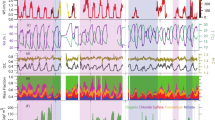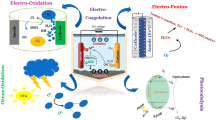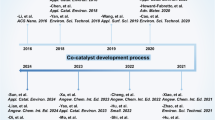Abstract
Hazardous organic wastes from industrial, military and commercial activities represent one of the greatest challenges to human beings. Advanced oxidation processes (AOPs) are alternatives to the degradation of those organic wastes. However, the knowledge about the exact mechanisms of AOPs is still incomplete. Here we report a phenomenon in the AOPs: induced effects, which is a common property of combustion reaction. Through analysis EDTA oxidation processes by Fenton and UV-Fenton system, the results indicate that, just like combustion, AOPs are typical induction reactions. One most compelling example is that pre-feeding easily oxidizable organic matter can promote the oxidation of refractory organic compound when it was treated by AOPs. Connecting AOPs to combustion, it is possible to achieve some helpful enlightenment from combustion to analyze, predict and understand AOPs. In addition, we assume that maybe other oxidation reactions also have induced effects, such as corrosion, aging and passivation. Muchmore research is necessary to reveal the possibilities of induced effects in those fields.
Similar content being viewed by others
Introduction
Hazardous organic wastes from industrial, military and commercial activities represent one of the greatest challenges to human beings1,2. Advanced oxidation processes (AOPs) are alternatives to the degradation of those organic wastes3,4,5. In 1987, Glaze et al.3 defined AOPs as “near ambient temperature and pressure water treatment processes which involve the generation of hydroxyl radicals in sufficient quantity to effect water purification”. The hydroxyl radical (·OH) is a powerful, highly reactive chemical oxidant, which reacts very quickly with organic compounds. Recently, other studies have suggested that, besides ·OH, AOPs can also generate other oxidizing species, such as sulfate radicals6,7. It is generally believed that, depending upon the nature of the organic species, they are oxidized by radicals mainly through hydrogen abstraction or addition itself to double bonds of the contaminant8.
AOPs are important tools for environmental technology, so they have to be placed on more sound scientific and engineering basis. However, the knowledge about the exact mechanisms of AOPs is still incomplete9,10. The most difficult problem is how to chooce or design the most efficient AOPs system for the given pollutant. So, the reaction mechanisms, efficiency improvement and their mathematical modeling will be the key subjects of the future research.
Some investigators called AOPs as “cold combustion”11,12. Just because, similar with combustion, AOPs is a kind of oxidation process which could oxidize and mineralize the organic matter under mild conditions. But we tried to discover more similarities between them and achieve some enlightenment which is helpful to analyze, predict, understand and improve the oxidation efficiency of AOPs. Here we report a similar phenomenon exist in the AOPs: induced effects, which is a general property of combustion reaction. In ancient times, human ancestors drilled wood to make fire. As a Chinese saying goes, “a single spark can start a prairie fire”. Both of them mean that combustion can be induced by a small fire. Our experimental results indicated that AOPs may also have induced effects. The following experimental findings directly or indirectly reflect the induced effects of AOPs from different angles.
Results and discussion
Fenton's reagent (mixture of hydrogen peroxide and ferrous iron) is one of the most effective AOPs, which was developed in the 1890s by Henry John Horstman Fenton as an analytical reagent13. Fenton's reaction is based on the catalyzed decomposition of H2O2 by ferrous iron to produce reactive ·OH14. It has been found effective in treating various industrial wastewater components including a wide variety of landfill leachate15, pesticides16 and surfactants17, as well as many other substances. Oxidations of ethylenediaminetetraacetic acid (EDTA) by Fenton's reagent were carried out in our experiments and the results are shown in Fig. 1. The results indicated that the reaction rate is very slow in the early stage of the reaction, only about 22% COD of EDTA have been oxidized in the first 25 min. Meanwhile, the solution temperature also raised very slowly, from 32°C raised to 42°C in the first 25 min. However, after this early stage, a sudden violent oxidation reaction has occurred and the temperature raised very quickly, reached 80°C in the 10 minutes. About 45% of EDTA oxidation have achieved in this 10 minutes. According to usually employed hydroxyl radical theory, it implies that a large number of ·OH produced at this stage. However, it is difficult to understand why a long waiting time is needed before producing those large number of ·OH. We believe that this is a induction reaction which just like the burning process of a pile of wood from hardly ignition to strong burning and finally burned out.
Comparison of oxidation efficiency of EDTA by different processes (b) and the changes in the temperature of the solution (a): (1) Fenton, (2) UV/Fenton, (3) Fenton + K2C2O4, (4) UV/Fenton + tert-butanol (5) Fenton + K2C2O4 + tert-butanol.
Experimental conditions: EDTA: 50 mM, H2O2: 1.5 M, Fe2+: 15 mM, K2C2O4: 11 mM, tert-butanol: 10 mM.
The oxidation efficiency of Fenton's reaction could be strongly accelerated by adding UV radiation18,19. Although 254 nm UV radiation could penetrate only a very short distance into the mixed solution of H2O2 and EDTA (Fig. 2). The result shows that addition of UV radiation could cut the waiting time of occurring violent oxidation reaction from 25 to 15 minutes (Fig. 1a). This phenomenon can also be explained by induced effects. Firstly, UV radiation could quickly initiate the oxidation reaction in the range where UV radiation could penetrate. Then, already happened reactions induce the whole reaction. In fact, researchers have developed a variety of methods to induce advanced oxidation reaction in recent decades, such as optical20, electrical21, ultrasonic22 and microwave23.
Inspired by the induced effects, we tried to feed easily oxidizable organic matter to promote the oxidation of refractory organic compound in the solution. The experiment results agree well with our notions. In the EDTA oxidation experiments using Fenton process, the method of pre-feeding potassium oxalate in the solution, similar with UV, could also cut the waiting time of occurring violent oxidation reaction. The reason for choosing the potassium oxalate as an example is that it will not add COD of the solution and then not affect the calculation of COD removal efficiency. According to the result, the addition of 11 mM potassium oxalate could cut the waiting time from 25 to 20 minutes when 50 mM EDTA was treated by Fenton process (Fig. 1). This means that the pre-oxidation of potassium oxalate could induce the oxidation of EDTA. It will be easily understood if we connect it with a very common practice: oil usually used to quickly induce a log of wood combustion. Using easily biodegraded organic matter, such as sucrose and starch24,25, to increase the biodegradation is a common method in the biological process. But this strategy is rarely used in the physicochemical method. To be sure, using easily oxidizable organic matter to promote the efficiency of AOPs has important practical value for the degredation of refractory organic compounds.
tert-Butanol, which is a strong radical scavenger, was adopted as the indicator for the hydroxyl radical type reaction. As shown in Fig. 1, the addition of tert-butanol markedly reduced the AOPs efficiency, indicating that the ·OH was the main active species in the process. The results suggested that these procedures (UV, K2C2O4) actually enhanced the hydroxyl radical production26,27.
In addition, it is well known that oxygen will not be consumed if there is no fuel in a combustion reaction. Similarly, when study the reaction of degradation organic compounds by UV/H2O2 process, we discovered that H2O2 will consumed very slowly if there is no organic compounds in the solution (Fig. 3). This is another phenomenon to reflect the similar of AOPs with combustion. Based on this experiment result, even though the exact mechanism involved are not known, it is understandable if we assume that organic compounds play an important role for ·OH production along with oxidant, catalyst, UV or other possible factors in the AOPs.
From the above experimental results and discussions, we hypothesize that AOPs may have induced effects, which is similar to combustion. Although the mechanism is unclear, the findings from those studies raise new thinking in the relationship of AOPs and combustion, especially about induced effects. For example, combustion reaction is induced by the heat, but what induced the reaction of AOPs? We hope others will take up the challenge to begin addressing this important issue. It not only helps us to understand the mechanism of AOPs in more depth but also help us to find new methods to improve its efficiency from the angle of induced effects. In addition, it will raise a bold ideas: maybe all oxidation reactions have induced effects, such as corrosion, aging and passivation. Muchmore research is necessary to reveal the possibilities of induced effects in those fields.
Methods
Chemicals
Ferrous sulfate (FeSO4·7H2O), Disodium EDTA (Na2H2EDTA), potassium oxalate (K2C2O4·2H2O), hydrogen peroxide (30%, w/w), sulfuric acid (98% w/w), tert-butanol and sodium hydroxide were obtained from Tianjin Chemical (Tianjin, China). All chemicals were analytical grade reagents and were used as received without further purification. Distilled water was used to prepare all experimental solutions.
Analysis methods
In the present experiments, in order to compare with combustion, the EDTA oxidation effect was reflected by measuring COD which was measured using Standard Method 5220D28. The hydrogen peroxide concentration were monitored by iodometric titration with sodium thiosulfate29. All measurements of UV light intensity were made by a fluorescence spectrometer (PerkinElmer LS-45). Absorption spectra were measured by a UV–vis spectrophotometer (Hitachi, model U-3010, Japan) at a fixed slit width (1 nm) using a 1-cm quartz cell.
Photoreactor
A lab-scale photoreactor has been designed for the batch experiments. The photoreactor has a total volume of 4 liters of capacity. The irradiation was provided by a low-pressure mercury lamp (Shenzhen Dohill Inc., 80 W electric power and 314 cm2 irradiation surface) with predominant UV intensity at 253.7 nm (75 mW/cm2 at the surface of the lamp). The lamp was vertically located in the center of the photoreactor.
Experimental procedures
4 liters experimental solutions were added to the photoreactor. Then, predetermined amounts of H2O2 were added into the photoreactor. For the Fenton and UV-Fenton reactions, predetermined amounts of Fe2+ were added into the photoreactor at the same time. Dark experiments were conducted under identical conditions without UV exposure. UV-Fenton reactions commenced when the UV light was turned on. At appropriate time intervals, 20 ml of the sample solution was removed from the photoreactor into the tubes for test. Each experiment was performed at least twice, except in the cases where the variation for replicate experiments exceeded 5%, more replications were performed. All the experiments and measurements were carried out at room temperature.
References
Orloff, K. & Falk, H. An international perspective on hazardous waste practices. Int. J. Hyg. Environ. Health 206, 291–302 (2003).
Levine, R. & Chitwood, D. D. Public health investigations of hazardous organic chemical waste disposal in the United States. Environ. Health Persp. 62, 415–422 (1985).
Glaze, W. H., Kang, J. W. & Chapin, D. H. The chemistry of water treatment processes involving ozone, hydrogen peroxide and UV-radiation. Ozone: Sci. Eng. 9, 335–352 (1987).
Andreozzi, R., Caprio, V., Insola, A. & Marotta, R. Advanced oxidation processes (AOP) for water purification and recovery. Catal. Today 53, 51–59 (1999).
Glaze, W. H. An overview of advanced oxidation processes: current status and kinetic models. Chem. Oxid. 2, 44–57 (1994).
Anipsitakis, G. & Dionysiou, D. D. Degradation of organic contaminants in water with sulfate radicals generated by the conjunction of peroximonosufate with cobalt. Environ. Sci. Technol. 37, 4790–4797 (2003).
Anipsitakis, G. & Dionysiou, D. D. Radical generation by the interaction of transition metals with common oxidants. Environ. Sci. Technol. 38, 3705–3712 (2004).
Legrini, O., Oliveros, E. & Braun, A. M. Photochemical processes for water treatment. Chem. Rev. 93, 671–698 (1993).
Munter, R. Advanced oxidation processes: current status and prospects. Proc. Estonian Acad. Sci. Chem. 50, 59–80 (2001).
Enoch, S. J. Chemical category formation and read-across for the prediction of toxicity. In:: Recent Advances in QSAR Studies: Methods and Applications Puzyn T., Leszczynski J., & Cronin M. T. D. (eds.) (Springer, London, 2010).
Oturan, M. A., Oturan, N., Lahitte, C. & Trevin, S. Production of hydroxyl radicals by electrochemically assisted Fenton's reagent: Application to the mineralization of an organic micropollutant, pentachlorophenol. J. Electroanal. Chem. 507, 96–102 (2001).
Comninellis, C. & Pulgarin, C. Anodic oxidation of phenol for waste water treatment. J. Appl. Electrochem. 21, 703–708 (1991).
Fenton, H. J. H. Oxidation of tartaric acid in presence of iron. J. Chem. Soc., Trans. 65, 899–911 (1894).
Neyens, E. & Baeyens, J. A review of classic Fenton's peroxidation as an advanced oxidation technique. J. Hazard. Mater. B98, 33–50 (2003).
Hermosilla, D., Cortijo, M. & Huang, C. P. Optimizing the treatment of landfill leachate by conventional Fenton and photo-Fenton processes. Sci. Total Environ. 407, 3473–3481 (2009).
Huston, P. L. & Pignatello, J. J. Degradation of selected pesticide active ingredients and commercial formulations in water by the photo-assisted Fenton reaction. Wat. Res. 33, 1238–1246 (1999).
Lin, S. H., Lin, C. M. & Leu, H. G. Operating characteristics and kinetic studies of surfactant wastewater treatment by Fenton oxidation. Wat. Res. 33, 1735–1741 (1999).
Hu, X., Wang, X., Ban, Y. & Ren, B. A comparative study of UV-fenton, UV-H2O2 and fenton reaction treatment of landfill leachate. Environ. Technol. 32, 945–951 (2011).
Deng, Y. & Englehardt, J. D. Treatment of landfill leachate by the Fenton process. Water Res. 40, 3683–3694 (2006).
Shemer, H., Kunukcu, Y. K. & Linden, K. G. Degradation of the pharmaceutical Metronidazole via UV, Fenton and photo-Fenton processes. Chemosphere 63, 269–276 (2006).
Kaba, L., Hitchens, G. D. & Bockris, J. M. Electrochemical incineration of wastes. J. Electrochem. Soc. 137, 1341–1345 (1990).
Wu, Z. L., Ondruschka, B. & Cravotto, G. Degradation of phenol under combined irradiation of microwaves and ultrasound. Environ. Sci. Technol. 42, 8083–8087 (2008).
Ai, Z., Yang, P. & Lu, X. Degradation of 4–Chlorophenol by microwave irradiation enhanced advanced oxidation processes. Chemosphere 60, 824–827 (2005).
Bastioli, C., Cerutti, A., Guanella, I., Romano, G. C. & Tosin, M. Physical state and biodegradation behavior of starch-polycaprolactone systems. J. Env. Polym. Deg. 3, 81–95 (1995).
Ratto, J. A., Stenhouse, P. J., Auerbach, M., Mitchell, J. & Farrell, R. Processing, performance and biodegradability of a thermoplastic aliphatic polyester/starch system. Polymer 40, 6777–6788 (1999).
Xing, S. T., Hu, C., Qu, J. H., He, H. & Yang, M. Characterization and reactivity of MnOx supported on mesoporous zirconia for herbicide 2, 4-D mineralization with ozone. Environ. Sci. Technol. 42, 3363–3368 (2008).
Ji, F., Li, C., Zhang, J. & Deng, L. Efficient decolorization of dye pollutants with LiFe(WO4)2 as a reusable heterogeneous Fenton-like catalyst. Desalination 269, 284–290 (2011).
Wild, P. W. Modern analysis for electroplating 324–328 (Fin. Pub., England, 1974).
Schumb, W. C. & Satterfield, C. N. Hydrogen Peroxide Wentworth R. L. (ed.) 557–558 (Reinhold, New York, 1955).
Acknowledgements
This work was supported by grant 51178135 from National Natural Science Foundation (P.R. China).
Author information
Authors and Affiliations
Contributions
P.L., C.L. and Z.Z. designed the study and performed most experiments, assisted by G.L. and W.Z., P.L. and H.C. analysed the data. P.L. and C.L. wrote the manuscript. All authors discussed the results and commented on the manuscript.
Ethics declarations
Competing interests
The authors declare no competing financial interests.
Rights and permissions
This work is licensed under a Creative Commons Attribution-NonCommercial-ShareALike 3.0 Unported License. To view a copy of this license, visit http://creativecommons.org/licenses/by-nc-sa/3.0/
About this article
Cite this article
Liu, P., Li, C., Zhao, Z. et al. Induced effects of advanced oxidation processes. Sci Rep 4, 4018 (2014). https://doi.org/10.1038/srep04018
Received:
Accepted:
Published:
DOI: https://doi.org/10.1038/srep04018
This article is cited by
-
In situ anchor of magnetic Fe3O4 nanoparticles onto natural maifanite as efficient heterogeneous Fenton-like catalyst
Frontiers of Materials Science (2016)
-
Evaluation of toxicity and estrogenicity of the landfill-concentrated leachate during advanced oxidation treatment: chemical analyses and bioanalytical tools
Environmental Science and Pollution Research (2016)






